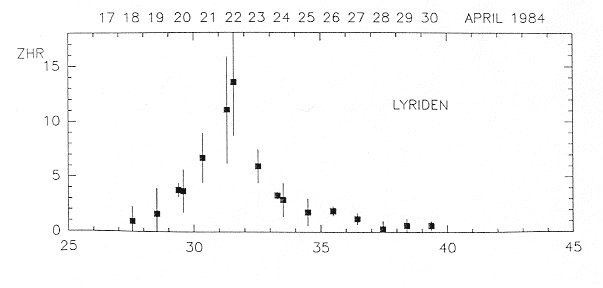 |
This page provides information on meteor streams visible from the Northern hemisphere which are
active in the current and next month. Information will be frequently updated for that purpose. In
addition, information about special events (e.g. stream outbursts) is available if such an event is
anticipated. Mentioned stream data and peak locations are based on Astronomy and Astrophysics
Vol. 287 (1994), 990-1013 (P. Jenniskens: meteor stream activity I. Annual streams) and
subsequent revisions. ZHR alfa Monocerotids. Dr. Peter Jenniskens (NASA-Ames Research Centre): Meteor Stream Activity; II. Meteor Outbursts. Astronomy and Astrophysics 295, 206-235 (1995) |
Contents:
General information April and May
We have now entered the quiet months of the year. Sporadic activity is at its annual low in this time of the year, and streams active are mostly minor streams. Exceptions are the Lyrids late April, and the eta Aquarids early may.
Stream activity in this part of the yearly cycle is still relatively ill surveyed. Many mysterious small streams hide in the sporadic background, and in the Northern hemisphere nights are relatively short. A lot is still unknown, and observational efforts are therefore very valuable. To this author, this is his favorit time of the year for observing. There's still a lot to be discovered, some of the minor streams (e.g. the Scorpiid complex) produce beautifull meteors, night temperatures are pleasant, the starry night sky overwhelming, the bats are out, and frogs join in an enchanting nightly choir.
mu Virginids (April 29/30)
A minor stream part of the large Virginid complex, and one of the better recognizable substreams. Maximum is ill defined and occurs near April 29 (radiant RA 229d, dec. -7d); the stream is also well recognizable however during the Lyrid maximum, when the radiant is located at RA 225d, dec. -5d. It are medium to slow meteors (~30 km/s, similar to Taurids). Maximum ZHR is in the order of 2-3. During maximum, the moon is absent in the second part of the night as the radiant is rising.
Lyrids (April 22/23)
One of the few Northern hemisphere springtime streams that produces a
conspicuous activity. The stream has a low level activity extending over
a week, and a steep and shortlived maximum taking a few hours. Maximum
activity is around ZHR 15. This year, the maximum occurs around 20h UT on
April 22. West Asia and Europe therefore will be favoured most. There is
little interfering moonlight excpet for the rising slope of activity (new
moon April 26): the moon rises only during morning twilight at the night of
maximum.
Lyrids are on the edge of medium to fast velocity, ~49 km/s. During
maximum the radiant is located at RA 272d, dec. +33d, at the Lyra/Her border.
 |
 |
eta Aquarids (May 6/7)
One of the major streams of the year, but only well observable from the
southern hemisphere. In the northern hemisphere, usefull observations are
only possible below 40d latitude North, during the last hour of the night.
The stream originates from comet P/Halley and is the twin-stream of the
Orionids in October. Like the Orionids, the meteors are very fast (~66
km/s). The radiant is located at RA 338d, dec. -1d at maximum, in the
lower part of the small asterix of Aquarius (known as the 'Mercedes' by
Dutch observers).
ZHR-values given for this stream differ between as low as 35 and as high
as 100. The stream is suspect of showing erratic shortlived outbursts
from time to time.
Although serious observations are out of the question, some observers at
high northern latitudes have made it into a sport to catch the odd
Aquarid deep in twilight. At the Latitude of The Netherlands (52d N), the
radiant has an altitude of only 2 degrees (!) when twilight starts, and
is still below 10 degrees when twilight becomes too strong to continue
observing. Still, meteors of the stream can be seen. Rudolf Veltman was
perhaps the first to observe an eta Aquarid from The Netherlands in 1983.
In 1995, Koen Miskotte and I spend three mornings hunting untill deep
into twilight, harvesting 4 possible streammembers. In 1996, a stroke of
good fortune brought me 3 eta aquarids in one morning twilight session.
This year, conditions are excellent: no moonlight will interfere.
alpha Scorpids (May 16/17)
Part of a large stream complex, building on the Virginids. Activity is
low, the radiant altitudes remain low for the Northern hemisphere, but
the streams are recognizable.
The alfa Scoorpiids have a broad activity stretching over 2 to 3 weeks
with a peak near May 17. They are mediumfast (35 km/s, like Geminids),
often appearing as greenish 'balls with tails'. Radiant is at RA 240d, dec.
-25d during maximum, near alfa Sco (drift +1.1d, -0.2d in RA and Dec. per
day). Before maximum, moon interferes early in the night, after maximum
it is absent (last quarter May 19).
omega Scorpids (June 2/3)
Part of the same complex as the alfa Scorpiids, but with a peak near June 2 and slightly higher activity. Radiant at RA 239d, dec. -20d at maximum (drift +1.0, -0.1 per day). Activity stretches at least two weeks. The meteors are very slow (21 km/s). Some moonlight will interfere with maximum.